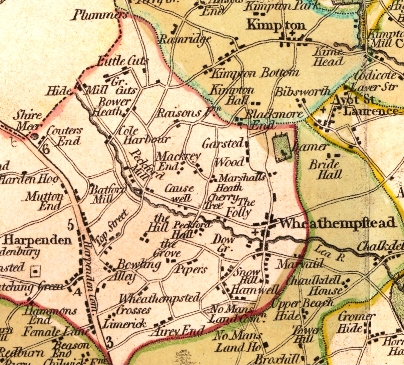Cutts Farm, Wheathampstead
May, 2007
John Davenport (daven.j.c @t bigpond.com) of Perth, W. Australia, writes: I am currently researching William Kentish Nicholl who died in 1731. In his Will William names a number of properties, including Cutts Farm lying in the Parishes of Wheathamstead & Luton in the Counties of Hertford and Bedford. How can I find out more about these individual properties?
|
|
What were known as Great and Little Cutts Farms appear to have been occupied by a John Cutt in 1525 [The Place-names of Hertfordshire]. As Charles Smith's map shows they are close to the county boundary with Bedfordshire, and the parish of Luton. They are shown in more detail, together with the adjacent Bedfordshire farms, in Dury and Andrews map of 1766, which has recently been reprinted with an index. I have not seen the Wheathampstead tithe award of 1840 and its associated map (manuscript copies held at HALS) but these should provide details of the individual buildings, fields (with field names and acreage) and owner/tenant details.
Wheathampstead and Harpenden (Book V) notes that in 1840 Great Cutts was recorded as having 240 acres - but is not mentioned by name in later censuses - suggesting that it may have merged with another farm. There are also various small 16th and 17th century references to the Cutts family in other volumes in the series. There is no mention of the farms, or the Cutts family at Wheathampstead, in the Victoria County History.
About Wheathampstead describes the farms as they were about 50 years ago:
Even further off, the outlying farms of Bower Heath, the Dane and Great and Little Cutts must have been almost completely isolated from the daily life of the village. We realised this when we talked to the family living at Little Cutts today, with all the advantages of modern transport. 'We don't really know Wheathampstead', they said, 'though of course we have been through it'. Probably a century or more ago the families there rarely troubled to make the journey. LITTLE CUTTS and GREAT CUTTS are on the western edge of the parish in real countryside. To find them you must ask your way from Sauncey Wood Lane, or take a good map. In the eighteenth century both farms belonged to the Cook family. Little Cutts was unique among the houses we visited in having retained its original plan from the seventeenth century. A little timber framed house of two storeys, it has an axial chimney stack with a small lobby in front of it. This opens on the left to a living room, with a heavily stopped beam, and on the right to a kitchen, with a wide inglenook fireplace. The kitchen has a little lean-to extension; the living room a second unheated room beyond it. The staircase remains in its original position, climbing up behind the very wide chimney from the living room to the bedrooms above. The road from Peters Green to Harpenden passed just outside the farm only ten years or so ago; and the farm was used as a beerhouse within living memory. Now, however, the road has been moved away, and the farm stands more quiet than ever.
From this point one can take the footpath or lane back to the Lower Luton Road at Coldharbour and then turn right for Mayfield Cottages, or one can continue up the edge of the field along the footpath that follows the route of the old road. Once over the brow of the hill, Great Cutts Farm is reached; by road it can be reached from Mayfield Cottages or from Bower Heath. The present farmhouse of Great Cutts is a modern house sheltered behind a group of trees. The old farmhouse is just past the barns and outbuildings, and now used as pigsties. This is a long building, originally similar in plan to Little Cutts, though larger. It has twice been extended in a northerly direction, and again at the back of the house where the roof has been brought down to cover it. In the course of time four new chimneys were added. The whole was bricked in during the nineteenth century, and this, probably, concealed original timbering and obscured any changes that have been made, such as in the position of the door. The lane beyond the farm runs straight down to Hyde Mill, which is still used as a working watermill by the grandson of the first Mr. Cole to own it.
So what next - because you are interested in pre-1730 references most will be held as manuscript documents in some archive or another, but you may be able to purchase photocopies in some cases. However many indexes are now coming online and a search of the National Archive web site for "Wheathampstead" and "Cutts" shows a number of promising references. Varying the search terms (including spellings) and extending the search into Bedfordshire include Luton, may well turn up more.
You may also get some ideas as to what else to look for by reviewing the answers I have given to other people relating to places.
There is a web page for Wheathampstead
If you can add to the information given above tell me.
